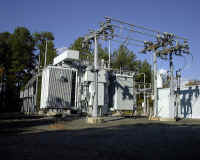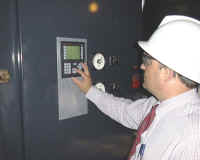|
Case
Study by Originally
published in Power Quality Assurance, July/August Issue. |
AutomatedBuildings.com
|
[an error occurred while processing this directive] |
|
Case
Study by Originally
published in Power Quality Assurance, July/August Issue. |
 Durham,
NC (December 1, 1999) --- It was
10:00PM on a steamy July night when Aurel Selezeanu’s pager went off, letting
him know that something was amiss in the electrical system that provides
critical power for Duke University and Medical Center in Durham, N.C. As
assistant director of the Electrical Services Unit of Duke’s Facilities
Management Department, he knew all too well that rapid response was necessary to
avert costly — and possibly life threatening — consequences. In the past the
pager’s insistent call meant immediately heading to his office on the Duke
campus to troubleshoot the problem. But on that July night, he would take a
different approach — from the comfort of his home, Selezeanu booted up his
laptop and within minutes was downloading a comprehensive array of data from
Duke’s advanced power metering system.
Durham,
NC (December 1, 1999) --- It was
10:00PM on a steamy July night when Aurel Selezeanu’s pager went off, letting
him know that something was amiss in the electrical system that provides
critical power for Duke University and Medical Center in Durham, N.C. As
assistant director of the Electrical Services Unit of Duke’s Facilities
Management Department, he knew all too well that rapid response was necessary to
avert costly — and possibly life threatening — consequences. In the past the
pager’s insistent call meant immediately heading to his office on the Duke
campus to troubleshoot the problem. But on that July night, he would take a
different approach — from the comfort of his home, Selezeanu booted up his
laptop and within minutes was downloading a comprehensive array of data from
Duke’s advanced power metering system.
After a quick analysis of the data, Selezeanu was able to identify a tap-switching problem in a distribution transformer. He made a call to Duke Power, the university’s energy service provider, and they were able to clear the switch without further intervention from Selezeanu or his team. Because the problem was caught and corrected rapidly, they averted outages that could have had serious consequences for sensitive hospital operations, university computers, people living on campus and more. Less than a week later he used the same method to catch and ward off problems from a potentially damaging over-voltage condition. As Selezeanu proudly observes, “In this business, it’s always best when you can proactively avoid an outage and we’ve designed our system with that in mind.”
The system implemented at Duke begins with 70 advanced power quality meters from Power Measurement Ltd. of Victoria, B.C., Canada. In order to capture maximum useable data from these meters, they rely on the firm’s PEGASYS® software, a comprehensive networked power monitoring, analysis and control system for Windows® NT. This software enables the unique “view anywhere” capability that allows Selezeanu to address a variety of power quality and management issues from his office or anywhere that he can plug in his laptop.
 Not
unlike a small city, Duke University consists of a total of 187 buildings
including 63 academic and research buildings, 44 medical center buildings, 9
athletics and recreation facilities, 26 residence halls, and 45 central campus
apartment complexes comprising over 4.5 million gross square feet of maintenance
space spread over 9,000 acres. The high voltage system, built in the early
1970s, includes five high voltage substations and four distribution stations.
Before implementing advanced metering, simply gathering basic electrical
information was a labor-intensive chore. Taking that information to the next
level – in a time of pending deregulation, increased demand, campus facilities
expansion and more sophisticated data requirements – was out of the
question without more extensive metering capabilities.
Not
unlike a small city, Duke University consists of a total of 187 buildings
including 63 academic and research buildings, 44 medical center buildings, 9
athletics and recreation facilities, 26 residence halls, and 45 central campus
apartment complexes comprising over 4.5 million gross square feet of maintenance
space spread over 9,000 acres. The high voltage system, built in the early
1970s, includes five high voltage substations and four distribution stations.
Before implementing advanced metering, simply gathering basic electrical
information was a labor-intensive chore. Taking that information to the next
level – in a time of pending deregulation, increased demand, campus facilities
expansion and more sophisticated data requirements – was out of the
question without more extensive metering capabilities.
[an error occurred while processing this directive]The selection of Power Measurement’s meters for the Duke campus involved a variety of considerations. Initially, Duke’s Electrical Services Unit was looking for solutions in preparation for deregulation. However, because deregulation was delayed in North Carolina, other issues came to the forefront. In addition to seeking ways to optimize power quality, they wanted better access to comprehensive data about all aspects of their rather extensive high voltage system. In the past they had tried to compare readings from more than 270 meters on campus with the limited information that came on the monthly utility bill to determine usage and load requirements as well as anticipate future needs. The magnitude of information required and difficulty of accumulating all of the necessary data were overwhelming.
After comparing the features of a number of SCADA systems, Selezeanu and his group initially chose a selection of 40 panel-mount meters from Power Measurement because “they are really a computer with a meter,” Selezeanu explained. Selected units included Power Measurement’s 7700 ION, 7300 ION, and 7330 ION advanced power quality meters along with their PEGASYS v2.0 power analysis software. Features that appealed to the Duke staff included: the extensive data recording and recall capabilities, detailed information about demand, consumption and peak shaving as well as the comprehensive reporting capability provided by the PEGASYS software. They also appreciated the fact that the software interface made it easy to exchange information with other applications including programs that they had developed internally to capture data.
All of the meters are based on Power Measurement’s unique ION® technology, an object-oriented architecture that gives them more flexibility and extensibility than any existing meters. This is important for simultaneously addressing the varied data and control needs of different facilities, departments and users. The ION architecture enables the meters to cost-effectively provide exactly the information or control functions required for various operations without having to buy separate meters for specialized applications.
“As we started to see results, we added more meters to the system and have about 70 installed now. In time, we plan to have advanced metering for everything on the mains because we are moving towards controlled consumption for the whole campus,” Selezeanu continued. He was also pleased to report that “with downtime estimated at about $10,000 per minute in our operation, the metering system paid for itself with just those two events in July.”
By installing the meters themselves, Duke’s operation’s personnel were able to further justify the cost of the new system. The meters are located at key locations throughout the campus and medical center complex. A central Windows NT server (located in Selezeanu’s office) running PEGASYS software is connected to each meter either through 10Base-T Ethernet links, RS-485 or RS-232 connections, or wireless radio modem links — depending on what is appropriate for a given location. The variety of built-in connectivity options — unique to Power Measurement’s meters — enables additional cost savings. “We use a combination of everything that’s available to communicate. It allows us to save on cables, manpower, everything…” according to Selezeanu.
 Besides
the obvious power quality benefits, the new metering system is taking the
guesswork out of Duke’s energy management operations. Where previously they
pieced together data from monthly utility bills and 270 separate meters, they
are now able to automatically gather real-time information from all over the
campus. Because the new system allows them to accurately estimate ahead of time
what their utility bills will be, they can plan and budget with far more
accuracy. Timely, detailed reports enable them to compare usage with previous
periods to determine if energy management plans are being effectively
implemented. In keeping with the university’s aggressive construction program
that has seen 14 new buildings added in the past decade, the Electrical Services
Unit is now able to proactively plan for future growth. Because their metering
system gives them detailed information about substation usage, capacity, voltage
drop and other factors they can accurately determine how much growth each
substation can handle or make precise cost justifications when new capital
equipment is required.
Besides
the obvious power quality benefits, the new metering system is taking the
guesswork out of Duke’s energy management operations. Where previously they
pieced together data from monthly utility bills and 270 separate meters, they
are now able to automatically gather real-time information from all over the
campus. Because the new system allows them to accurately estimate ahead of time
what their utility bills will be, they can plan and budget with far more
accuracy. Timely, detailed reports enable them to compare usage with previous
periods to determine if energy management plans are being effectively
implemented. In keeping with the university’s aggressive construction program
that has seen 14 new buildings added in the past decade, the Electrical Services
Unit is now able to proactively plan for future growth. Because their metering
system gives them detailed information about substation usage, capacity, voltage
drop and other factors they can accurately determine how much growth each
substation can handle or make precise cost justifications when new capital
equipment is required.
The combination of enhanced energy management features, minimized equipment costs and savings in labor combined with critically important power quality analysis tools have made the Power Measurement advanced metering program a major success behind the scenes at Duke University. And Aurel Selezeanu sleeps a little better at night knowing that he can address virtually any electrical problem at Duke with a few keystrokes on his laptop. “It’s important for people to know that with a beeper, managers can have complete control, security and assurance with a laptop connection from anywhere,” Selezeanu concluded.
[an error occurred while processing this directive]
[Click Banner To Learn More]
[Home Page] [The Automator] [About] [Subscribe ] [Contact Us]